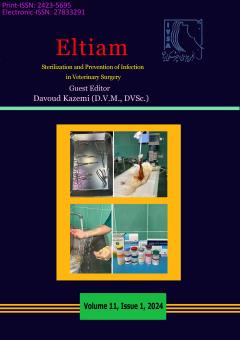Sterilization methods of surgical instruments
Subject Areas : Veterinary Soft and Hard Tissue SurgeryMohamad Shojaei 1 , Rahim Alizadeh 2 , Alireza Zokaie Ashtiani 3
1 - 1. Razi Vaccine and Serum Research Institute, Agricultural Research, Education and Extension Organization (AREEO), Karaj, Iran
2 - 2. Surgery department, Avina Vet Hospital, Tehran, Iran
3 - 2. Surgery department, Avina Vet Hospital, Tehran, Iran
Keywords: Sterilization, surgery, surgical equipment,
Abstract :
Background: A review of the sterilization principles in operation
Objectives: Declaration of the method of sterilization and disinfection of facilities and instruments.
Methods: Studying The literature has been published related to the sterilization approach and process.
Results: Understanding and properly performing sterilization and sanitization techniques are critical for reaching a successful surgery.
Sterilization is a precise term that means destroying all microorganisms in or on an object, including bacteria, viruses, spores, and fungi. Sterilization can be done through chemical or physical methods, with various advantages and disadvantages including speed, application, complications, and costs. There are a lot of dos and don'ts in this procedure.
The product's sterility assurance level is the probability that a viable microorganism is present on a product after sterilization. For sterilization, they mostly use steam under pressure, dry heat, and ethylene hydrogen oxide gas According to a classification, the equipment is classified into three critical, semi-critical, and non-critical categories. Essentially, critical equipment is those items that, if contaminated, are associated with a clinical risk of infection due to contact with the bloodstream or sterile tissues and, it is a must to be sterile to lead a good operation. This category includes surgical instruments, catheters, needles, and implants, which must be sterile. Semi-critical equipment comes into contact with mucous membranes or healthy skin, such as tracheal tubes, laryngoscopes, and esophageal probes. These items and instruments must be sterilized. Non-critical equipment are those that only come into contact with healthy skin. , such as stethoscopes, blood pressure cuffs, and wheeled beds for patient transfer, these items can be disinfected with medium-level disinfectants.
Conclusions: Reaching a certain sterilization needs accurate monitoring during the preparation of equipment for sterilization. It should be done scientifically to prevent infection and unwilling tolls.
1.
Rutala WA, Donskey CJ, Weber DJ. Disinfection and sterilization: New technologies. American Journal of Infection Control. 2023;51(11):A13-A21. 2.
Tobias K. Manual of small animal soft tissue surgery: John Wiley & Sons; 2017. 3.
Bahk MS. Smart Sterilization Container Technology: Blue Wrap Innovation. Journal of Orthopaedic Experience & Innovation. 2024. 4. Liu Q. Evaluation of the Impact of Refined Quality Control Management Model on the Qualified Rate of Disinfection and Sterilization of Surgical Instruments
in the Sterilization Supply Center. Journal of Clinical and Nursing Research. 2024;8(1):168-73. 5. Opaleva G, Garkusha I, Taran A, Gubarev S, Zolototrubova M, Makhlai V, et al. DEVELOPMENT OF MICROPROCESSOR BASED CONTROL SYSTEM FOR LOW-
TEMPERATURE PLASMA STERILIZER WITH ULTRASONIC CAVITATION. Problems of Atomic Science and Technology. 2023(6):148. 6.
Moss C, Isley MM. Sterilization: a review and update. Obstetrics and Gynecology Clinics. 2015(4)-713-724. 7.
CS Sousa, LM Torres, MPF Azevedo. Sterilization with ozone in health care: an integrative literature review. SciELO Brasil.2011(5) https://doi.org/10.1590/S0080-62342011000500030 8.
T Link. Guidelines in practice: sterilization packaging systems. AORN journal. Wiley Online Library2020, 112(3):248-260. https://doi.org/10.1002/aorn.13150.


